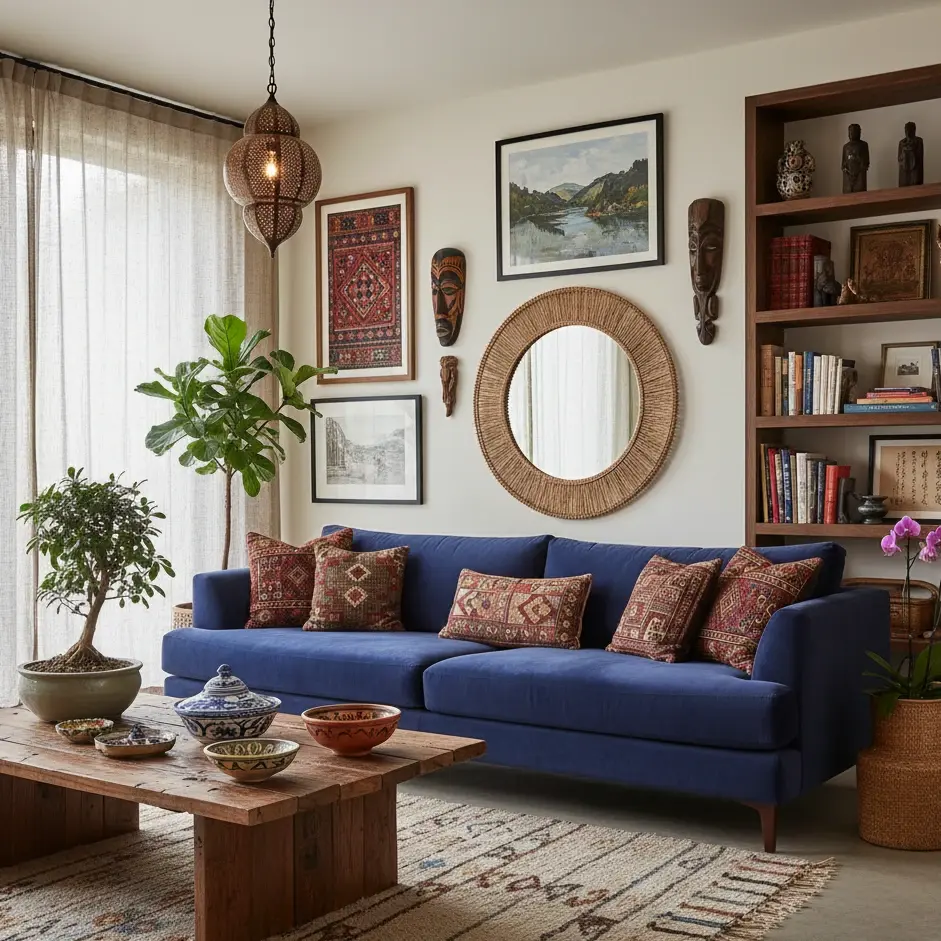Cultural Fusion in Decor: Incorporating Local Art & Craft into Global Design Concepts
- Amelia Roberts

- Sep 23
- 4 min read
Blend tradition with modern design by incorporating local art and craft into global decor concepts for a home rich in culture and personality.

In today's fast-paced, ever-changing world of interior design, cultural fusion has become one of the most thrilling methods of creating memorable and distinctive spaces. Whether it is a warm café, a lively bar, or a luxury hotel, the blending of local art and craft heritage with global design ideas brings authenticity, character, and a sense of narrative.
In an age where globalization has brought design trends everywhere, cultural eclecticism prevents spaces from getting caught in the generic trap.
Rather, they embody both the international design vocabulary of contemporary minimalism, industrial chic, or Scandinavian simplicity—and the local cultural wealth of handlooms, pottery, murals, and craft furniture.
This fusion isn't simply beautiful to behold—it's evocative. Consumers don't merely view the ambiance; they experience it, resonate with it, and sometimes recall the room long after they are gone.
Why Cultural Fusion Is the Future of Interior Design
Hospitality spaces today aren’t just places to eat or drink—they’re experiences. When people walk into a café or restaurant, they want more than coffee or cocktails. They want a mood, a vibe, and a story to tell on Instagram.
Cultural fusion provides that story. By weaving in local heritage and artistry, designers can:
Differentiate the space from competitors.
Engage customers emotionally, making them feel connected to the culture.
Support sustainability, since many crafts are eco-friendly.
Boost shareability, as unique décor often inspires photos and social media buzz.
The outcome? A space that feels modern yet timeless, familiar yet distinctive.
How to Integrate Local Art & Craft into International Design Ideas
Designing with cultural fusion is all about balance. The following are practical ways to integrate it without overdoing the space:
1. Textiles with Tradition
Handwoven textiles, embroidered pillows, or native designs can quickly tame contemporary interiors. A minimalist Scandinavian-themed café can be brought to life with bright Moroccan kilims, Indian block-printed drapes, or Peruvian woven blankets.
2. Handmade Furniture
Rather than factory-made chairs and tables, commissioning local artisans for bespoke woodwork or bamboo trim makes every item the centerpiece of a conversation. These original pieces have centuries of cultural history embedded within them.
3. Murals & Wall Art
Walls are empty canvases awaiting personality. Hiring a local artist to paint a mural may add some zest to a sterile space. For instance, a monochromatic restaurant could have a striking mural that draws from Latin American fables or tribal African motifs.
4. Lighting with Local Soul
Lighting is more than any other design element to create mood. Terracotta sconces, lanterns, or woven pendant lamps can create a cozy glow while also highlighting artisan skill. They also coordinate stunningly with global industrial or modern schemes.
5. Functional Décor Accents
Décor doesn’t have to be purely decorative. Locally made ceramics, baskets, or clay vessels can serve as tableware or storage while enhancing aesthetics. Even practical elements like window treatments can tell a cultural story. For instance, when you buy blinds, opting for fabrics inspired by local weaving traditions allows you to combine modern functionality with traditional beauty.
Trend Forecast: Cultural Fusion in 2026 and Beyond
Design trends evolve, but cultural fusion is here to stay. Here’s what to expect:
Sustainable Craftsmanship: Demand for eco-friendly décor will push designers toward organic fabrics, bamboo, clay, and reclaimed wood.
Hybrid Spaces: Cafés and bars will increasingly double as cultural hubs, showcasing local artwork and artisan pop-ups.
Tech Meets Tradition: Expect to see digital projection art paired with hand-painted murals or smart blinds designed with traditional fabrics.
Local Collaborations: More designers will collaborate directly with regional craftspeople, ensuring authenticity and community support.
Real-World Inspirations
Tokyo Meets Mexico: A Japanese-inspired sushi bar with bold Mexican Talavera tiles creates a balance of minimalism and vibrancy.
Scandinavian + African Fusion: Clean, white Nordic furniture paired with vibrant African wax-print cushions and rugs.
Mediterranean Coastal + Greek Pottery: Modern Greek cafés blending whitewashed walls with hand-thrown pottery from local artisans.
Industrial Chic + Indigenous Art: Concrete and steel interiors softened by indigenous textiles, beadwork, or tribal paintings.
Each of these examples shows how global design can be elevated when blended with local heritage.
The Business Advantage of Cultural Fusion
For café, bar, and restaurant owners, this approach is not only visually impactful—it’s a smart business move:
Customers are more likely to post about a space that feels unique.
Story-driven interiors create stronger brand loyalty.
Supporting local crafts builds community trust and goodwill.
Authentic décor enhances word-of-mouth marketing.
When guests feel that a space is rooted in culture, they’re not just customers—they become advocates.
Final Thoughts
Cultural fusion in décor isn't a matter of conflicting design styles—it's all about harmony and story. It's all about designing spaces that are at once global and deeply local, stylish and soulful.
By combining local craft and art traditions into international design concepts, cafes, restaurants, and bars are able to create experiences that transcend beauty.
Ultimately, design is not just about decoration—it's about connection. And cultural fusion makes the type of connection that remains in memory, speaks to identity, and invites people to return time and again.



Comments